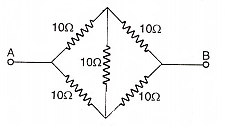 Multiple Choice Questions
Multiple Choice QuestionsKirchhoff's law of junction, I = 0, is based on :
conservation of energy
conservation of charge
conservation of energy as well as charge
conservation of momentum
If the percentage change in current through a resistor is 1%, then the change in power through it would be:
1 %
2 %
1.7 %
0.5 %
3 identical bulbs are connected in series and these together dissipate a power P. If now the bulbs are connected in parallel, then the power dissipated will be:
P/3
3P
9P
P/9
What is the drift velocity of electrons if the current flowing through a copper wire of 1 mm diameter is 1.1 A. Assume that each atom of copper contributes one electron : (Given: density of Cu = 9 g/cm3 and atomic weight of Cu = 63)
0.3 mm/s
0.5 mm/s
0.1 mm/s
0.2 mm/s
The equivalent resistance between A and B is

10 Ω
20 Ω
30 Ω
49 Ω
A.
10 Ω
The given circuit is a balanced Wheatstone bridge. So, resistance connected across diagonal will be meaningless.
Equivalent resistance of upper arm(R1) and lower arm(R2)
R1 = R2 = 10 + 10 = 20 Ω
R1 and R2 are in parallel, so,
= 10 Ω
An electrical cable of copper has just one wire of radius 9 mm. Its resistance is 5Ω. The single wire of the cable is replaced by 6 different well-insulated copper wires each of radius 3 mm. The total resistance of the cable will now be equal to:
270 Ω
90 Ω
45 Ω
7.5 Ω
A current of 2 amperes flowing through a conductor produces 80 joules of heat in ten seconds. The resistance of the conductor is:
0.5 Ω
2 Ω
4 Ω
20 Ω
A thermoelectric refrigerator works on
Joule effect
Seebeck effect
Peltier's effect
Thermionic effect
